Execution of a Viet Cong Guerrilla [1968]
This picture was shot by Eddie Adams who won the Pulitzer prize with it. The picture shows Nguyen Ngoc Loan, South Vietnam's national police chief executing a prisoner who was said to be a Viet Cong captain. Once again the public opinion was turned against the war.
By Eddie Adams
The lynching of young blacks [1930]
This is a famous picture, taken in 1930, showing the young black men accused of raping a Caucasian woman and killing her boyfriend, hanged by a mob of 10,000 white men. The mob took them by force from the county jail house. Another black man was left behind and ended up being saved from lynching. Even if lynching photos were designed to boost white supremacy, the tortured bodies and grotesquely happy crowds ended up revolting many.
By Lawrence Beitler
Soweto Uprising [1976]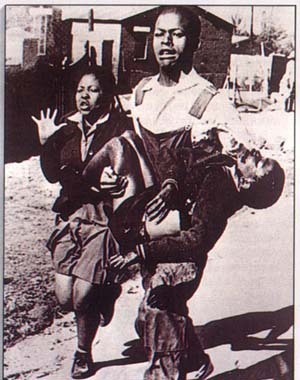
It was a picture that got the world's attention: A frozen moment in time that showed 13-year-old Hector Peterson dying after being struck down by a policeman's bullet.
By Sam Nzima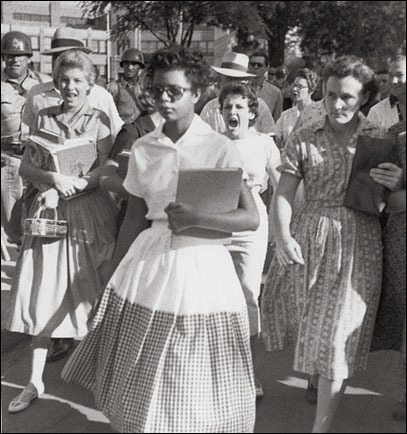
Hazel Bryant [1957]
It was the fourth school year since segregation had been outlawed by the Supreme Court. Things were not going well, and some southerners accused the national press of distorting matters. This picture, however, gave irrefutable testimony, as Elizabeth Eckford strides through a gantlet of white students, including Hazel Bryant (mouth open the widest), on her way to Little Rock's Central High.
By Will Counts
Triangle Shirtwaist Company Fire [1911]
The Triangle Shirtwaist Company always kept its doors locked to ensure that the young immigrant women stayed stooped over their machines and didn't steal anything. When a fire broke out on Saturday, March 25, 1911, on the eighth floor of the New York City factory, the locks sealed the workers' fate. In just 30 minutes, 146 were killed. Witnesses thought the owners were tossing their best fabric out the windows to save it, then realized workers were jumping, sometimes after sharing a kiss (the scene can be viewed now as an eerie precursor to the World Trade Center events of September, 11, 2001, only a mile and a half south). The Triangle disaster spurred a national crusade for workplace safety.
Phan Thi. Kim Phúc [1972]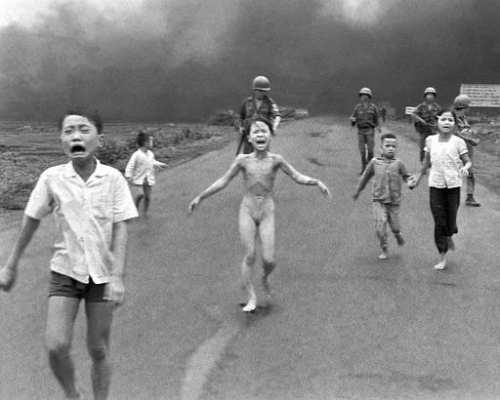
Phan Thi. Kim Phúc known as Kim Phuc (born 1963) was the subject of a famous photo from the Vietnam war. The picture shows her at about age nine running naked after being severely burned on her back by a napalm attack.
By Huy..nh Công Út
Kent State [1970]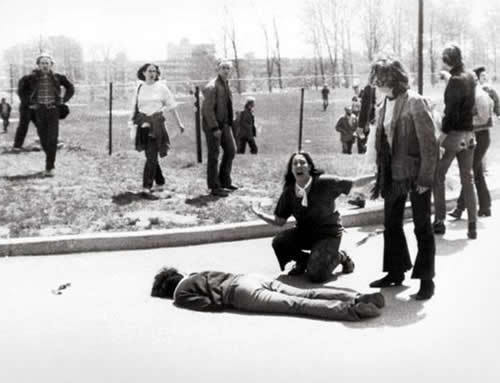
The news that Richard Nixon was sending troops to Cambodia caused a chain of protests in the U.S. colleges. At Kent State the protest seemed more violent, some students even throwing rocks. In consequence, The Ohio National Guard was called to calm things down, but the events got out of hand and they started shooting. Some of the victims were simply walking to school. The photo shows 14-year-old Mary Ann Vecchio kneeling over the body of Jeffrey Miller who had been shot by the Ohio National Guard moments earlier.
By John Paul Filo
Tiananmen Square [1989]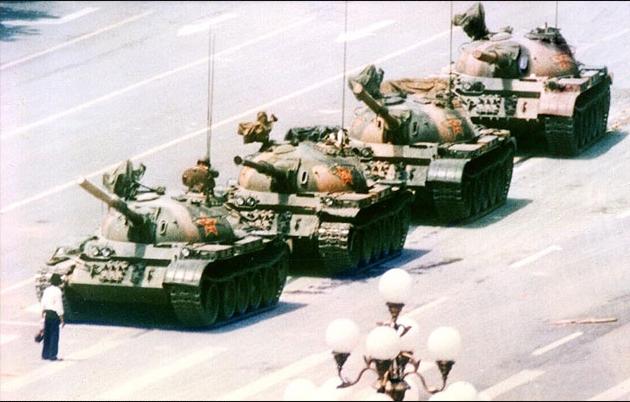
This is the picture of a student/man going to work who has just had enough. The days leading up to this event thousands of protesters and innocent by standers were killed by their own government because the Chinese people wanted more rights. He tries to stop the tanks in Tiananmen Square by standing in front of them and climbed on the tank and hitting the hatch and yelling, the tank driver didn't crush the man with the bags as a group of unknown people came and dragged him away, we still don't know if the man is alive or dead as the Chinese government executed many of the protesters involved. China is still controlled by a communist regime, but while there are strong willed men like this the country still has hope.
By Jeff Widener
Thích Qua?ng ?u+'c [1963]
Thích Qua?ng Ðu+'c was a Vietnamese Buddhist monk who burned himself to death at a busy Saigon intersection on June 11, 1963. His act of self-immolation, which was repeated by others, was witnessed by David Halberstam, a New York Times reporter, who wrote:
" I was to see that sight again, but once was enough. Flames were coming from a human being; his body was slowly withering and shriveling up, his head blackening and charring. In the air was the smell of burning human flesh; human beings burn surprisingly quickly. Behind me I could hear the sobbing of the Vietnamese who were now gathering. I was too shocked to cry, too confused to take notes or ask questions, too bewildered to even think.... As he burned he never moved a muscle, never uttered a sound, his outward composure in sharp contrast to the wailing people around him."
By Arthur Sasse
Nagasaki [1945]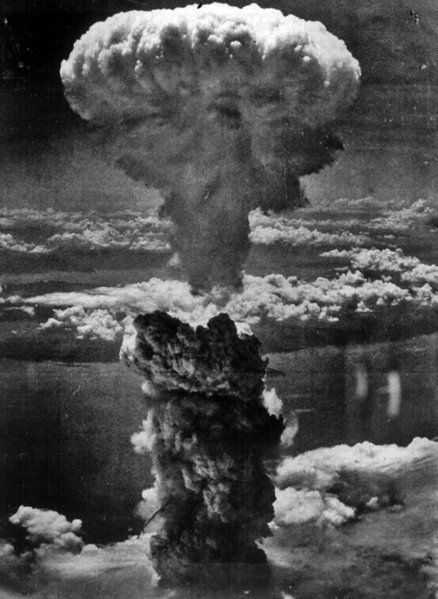
This is the picture of the "mushroom cloud" showing the enormous quantity of energy. The first atomic bomb was released on August 6 in Hiroshima (Japan) and killed about 80,000 people. On August 9 another bomb was released above Nagasaki. The effects of the second bomb were even more devastating - 150,000 people were killed or injured. But the powerful wind, the extremely high temperature and radiation caused enormous long term damage.
Hiroshima, Three Weeks After the Bomb [1945]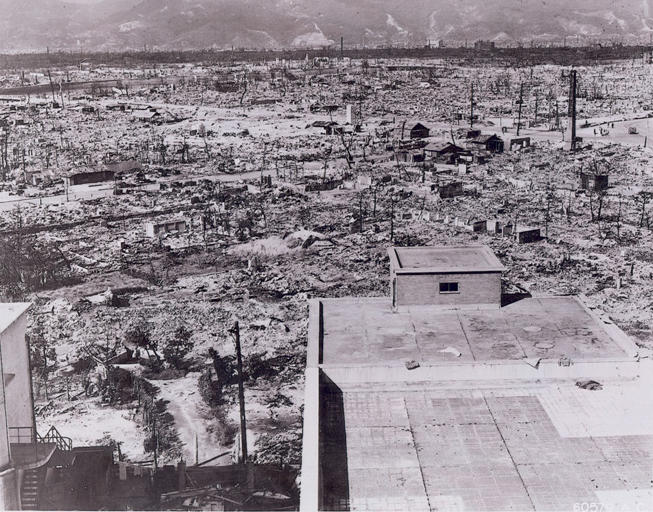
Americans -- and everyone -- had heard of the bomb that "leveled" Hiroshima, but what did that mean? When the aerial photography was published, that question was answered.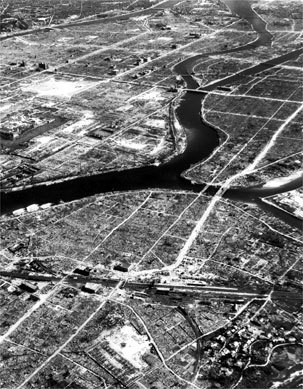
And here is a ground view of the destruction.
Dead on the Beach [1943]
Haunting photograph of a beach in Papua New Guinea on September 20, 1943, the magazine felt compelled to ask in an adjacent full-page editorial, "Why print this picture, anyway, of three American boys dead upon an alien shore?" Among the reasons: "words are never enough . . .
By George Strock
Buchenwald [1945]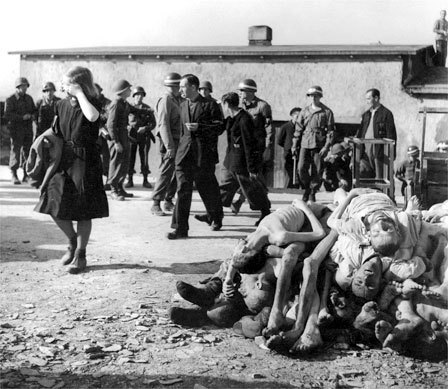
George Patton's troops when they liberated the Buchenwald concentration camp. Forty-three thousand people had been murdered there. Patton was so outraged he ordered his men to march German civilians through the camp so they could see with their own eyes what their nation had wrought.
Anne Frank [1941]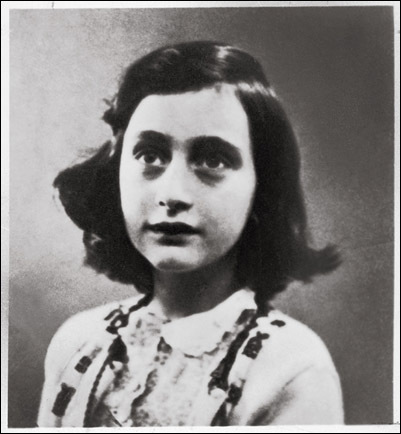
Six million Jews died in the Holocaust. For many throughout the world, one teenage girl gave them a story and a face. She was Anne Frank, the adolescent who, according to her diary, retained her hope and humanity as she hid with her family in an Amsterdam attic. In 1944 the Nazis, acting on a tip, arrested the Franks; Anne and her sister died of typhus at Bergen-Belsen only a month before the camp was liberated. The world came to know her through her words and through this ordinary portrait of a girl of 14. She stares with big eyes, wearing an enigmatic expression, gazing at a future that the viewer knows will never come.
V-J Day, Times Square, [1945]
or "The Kiss", at the end of World War II, in US cities everybody went to the streets to salute the end of combat. Friendship and unity were everywhere. This picture shows a sailor kissing a young nurse in Times Square. The fact is he was kissing every girl he encountered and for that kiss, this particular nurse slapped him.
By Alfred Eisenstaedt
Casualties of war [1991]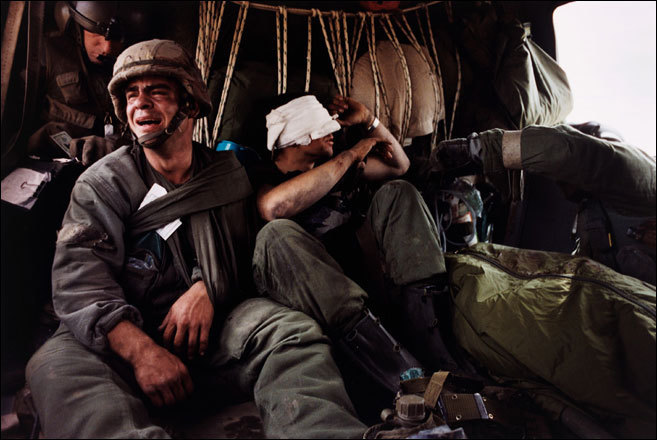
Image of a young US sergeant at the moment he learns that the body bag next to him contains the body of his friend, killed by "friendly fire".
The widely published photo became an iconic image of the 1991 Gulf war - a war in which media access was limited by Pentagon restrictions.
By David Turnley
The Falling Man [2001]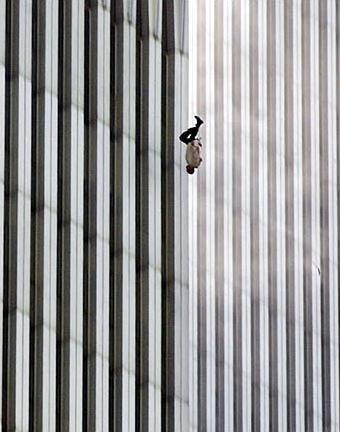
The powerful and controversial photograph provoked feelings of anger, particularly in the United States, in the immediate aftermath of the September 11 attacks. The photo ran only once in many American newspapers because they received critical and angry letters from readers who felt the photo was exploitative, voyeuristic, and disrespectful of the dead. This led to the media's self-censorship of the photograph, preferring instead to print photos of acts of heroism and sacrifice.
Drew commented about the varying reactions, saying, "This is how it affected people's lives at that time, and I think that is why it's an important picture. I didn't capture this person's death. I captured part of his life. This is what he decided to do, and I think I preserved that."9/11: The Falling Man ends suggesting that this picture was not a matter of the identity behind the man, but how he symbolized the events of 9/11.
U.S. Marines raising the flag on Iwo Jima [1945]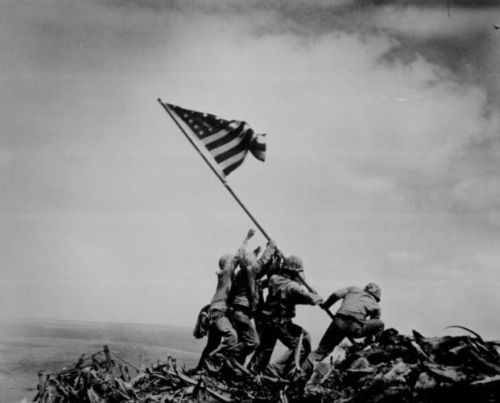
Raising the Flag on Iwo Jima is a historic photograph taken on February 23, 1945, by Joe Rosenthal. It depicts five United States Marines and a U.S. Navy corpsman raising the flag of the United States atop Mount Suribachi during the Battle of Iwo Jima in World War II.
The photograph was extremely popular, being reprinted in thousands of publications. Later, it became the only photograph to win the Pulitzer Prize for Photography in the same year as its publication, and ultimately came to be regarded as one of the most significant and recognizable images of the war, and possibly the most reproduced photograph of all times.
By Joe Rosenthal
Lunch atop a Skyscraper [1932]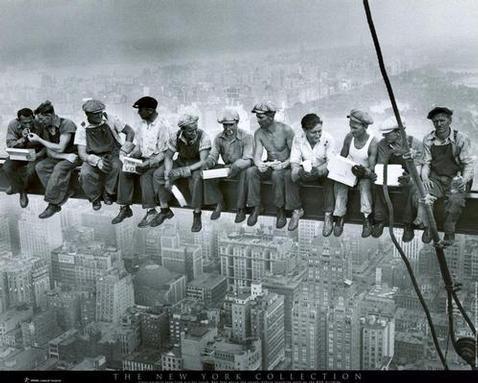
Lunch atop a Skyscraper (New York Construction Workers Lunching on a Crossbeam) is a famous photograph taken by Charles C. Ebbets during construction of the GE Building at Rockefeller Center in 1932.
The photograph depicts 11 men eating lunch, seated on a girder with their feet dangling hundreds of feet above the New York City streets. Ebbets took the photo on September 29, 1932, and it appeared in the New York Herald Tribune in its Sunday photo supplement on October 2. Taken on the 69th floor of the GE Building during the last several months of construction, the photo Resting on a Girder shows the same workers napping on the beam.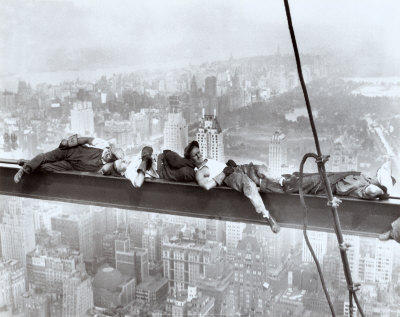
Here's a rare image by the same photographer showing the workers sleeping on the crossbeam.
Migrant Mother [1936]
For many, this picture of Florence Owens Thompson (age 32) represents the Great Depression. She was the mother of 7 and she struggled to survive with her kids catching birds and picking fruits. Dorothea Lange took the picture after Florence sold her tent to buy food for her children. She made the first page of major newspapers all over the country and changed people's conception about migrants.
By Dorothea Lange
Omayra Sánchez [1985]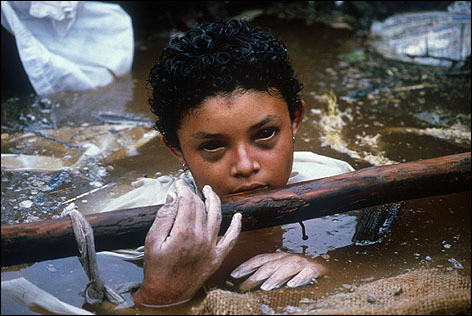
Red Cross rescue workers had apparently repeatedly appealed to the government for a pump to lower the water level and for other help to free the girl. Finally rescuers gave up and spent their remaining time with her, comforting her and praying with her. She died of exposure after about 60 hours.
By Frank Fournier
A vulture watches a starving child [1993]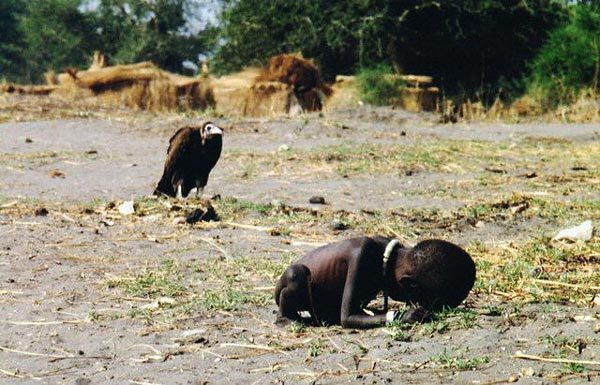
The prize-winning image: A vulture watches a starving child in southern Sudan, March 1, 1993.
Carter's winning photo shows a heart-breaking scene of a starving child collapsed on the ground, struggling to get to a food center during a famine in the Sudan in 1993. In the background, a vulture stalks the emaciated child.
Carter was part of a group of four fearless photojournalists known as the "Bang Bang Club" who traveled throughout South Africa capturing the atrocities committed during apartheid.
Haunted by the horrific images from Sudan, Carter committed suicide in 1994 soon after receiving the award.
By Kevin Carter
Biafra [1969]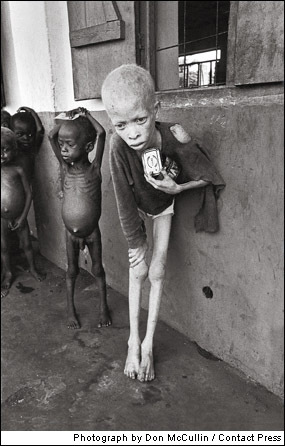
When the Igbos of eastern Nigeria declared themselves independent in 1967, Nigeria blockaded their fledgling country-Biafra. In three years of war, more than one million people died, mainly of hunger. In famine, children who lack protein often get the disease kwashiorkor, which causes their muscles to waste away and their bellies to protrude. War photographer Don McCullin drew attention to the tragedy. "I was devastated by the sight of 900 children living in one camp in utter squalor at the point of death," he said. "I lost all interest in photographing soldiers in action." The world community intervened to help Biafra, and learned key lessons about dealing with massive hunger exacerbated by war-a problem that still defies simple solutions.
By Don McCullin
Misery in Darfur [2004]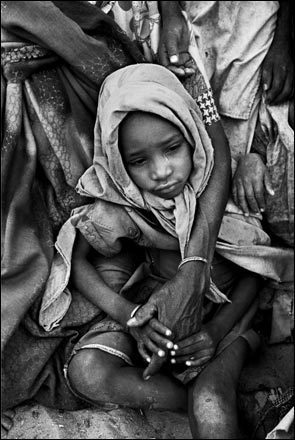
It's an image which depicts a depressed, shoulders-down figure of a child in a cluster of what remains of her family.
The very weather-beaten arm of her mother goes over her left shoulder and there are the very small weather-beaten hands of the child, who is about five or six, clinging on to this one piece of security that she has, which is the weather-beaten hand of her mother.
The mother is not in the image, she's in the background. But then slightly further in the background you see the other hands of her brothers and sisters as they wait in this village.
By Marcus Bleasdale
Tragedy in Oklahoma [1995]
The fireman has taken the time to remove his gloves before receiving this infant from the policeman.
Anyone who knows anything about firefighters know that their gloves are very rough and abrasive and to remove these is like saying I want to make sure that I am as gentle and as compassionate as I can be with this infant that I don't know is dead or alive.
The fireman is just cradling this infant with the utmost compassion and caring.
He is looking down at her with this longing, almost to say with his eyes: "It's going to be OK, if there's anything I can do I want to try to help you."
He doesn't know that she has already passed away.
By Chris Porter
How Life Begins [1965]
In 1957 he began taking pictures with an endoscope, an instrument that can see inside a body cavity, but when Lennart Nilsson presented the rewards of his work to LIFE's editors several years later, they demanded that witnesses confirm that they were seeing what they thought they were seeing. Finally convinced, they published a cover story in 1965 that went on for 16 pages, and it created a sensation. Then, and over the intervening years, Nilsson's painstakingly made pictures informed how humanity feels about . . . well, humanity. They also were appropriated for purposes that Nilsson never intended. Nearly as soon as the 1965 portfolio appeared in LIFE, images from it were enlarged by right-to-life activists and pasted to placards.
By Lennart Nilsson
Music: vernacular of the soul
Friday, February 15, 2008
Wrinkles in Time-Words Are Never Enough
Posted by dejanae at 2:35 AM
Subscribe to:
Post Comments (Atom)










15 public opinion:
some of those were very depresing,on a brighter note
hope u had a nice valentines
Wow, very provacative pics. That 9-11 pic still resonates in my memory to this day. Good post.
Wow.
I want to say something profound but I can't come up with anything.
Just wow. and thanks.
Howdy! First time visitor.
I liked the post it was kind of sad yet thought provoking.
Alot of this pictures left me speechless. Just some sad stuff all the way around in a few of 'em...the starving kids, the wars, the dude falling from the sky on 9/11, the racism-based, etc.
I enjoyed the post, but I am convinced this world is a sad place.
Then, you have Bohemian Rhapsody playing the background.
fresh and fab:
thnx hon
it was just aiight
hope to spot u round these parts again
minerva:
yep
i remember it like it was yesterday
where i was
what i was doin
sula:
sometimes there are just no words
freakydeaky:
thank u come again
and that avatar is twisted
i like it
don:
yep this world can be hella fucked up at times
You know what's ill? I still see the towers standing. I still see me having lunch in that courtyard area listening to the performances in the summer and then walking to Century 21. Guess I just don't want to accept.
Those pics are disturbing forreal. some upsetting stuff, especially the starving children... damn
I experienced so many emotions while going through this post...sadness, anger, almost faithless, but i know with every evil deed, there is also some good being done, there has to be a balance...i have to keep believing in that. But this was very educational and sometimes we just need to know these things, it really puts life, this world in perspective.
fresh:
yep
denial is a mother
caeser:
disturbing but eye-opening
miz:
exactly
makes you evaluate life
Just like you said, words fail here
When I look at these images, I am also reminded of the horrible scenes shown of our people in New Orleans after THE hurricane.
Thank you for sharing, hope world is getting better..
shintakisworo.multiply.com
Thank you for posting these iconic photos.
We can see them no matter how many times and we'll always be shocked and ask: "When will "they" learn?"
I know this was posted 3 years ago but I think I had to fix my heart every time I saw and read from each picture. This world is an amazing place with amzingly f'd up people in it
Post a Comment